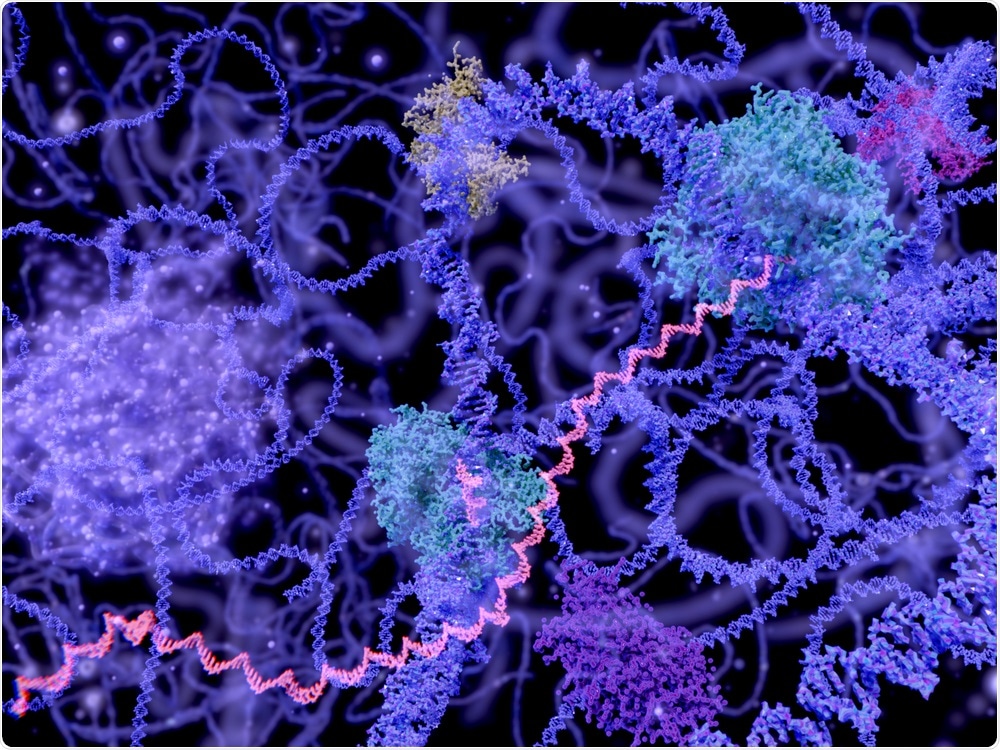A group of researchers headed by scientists from Baylor College of Medicine and the Czech Academy of Sciences recently unearthed vital information on how gene expression is orchestrated.

Image Credit: Juan Gaertner/Shutterstock.com
The results unravel a new process that coordinates the assembly of components within cells that regulate gene expression. This process is crucial for normal cell function, along with being implicated in neurodegeneration, cancer, and HIV infection. The mechanism can also suggest new means to treat these conditions. The research was published in the Science journal.
Most previous studies have focused on particular cellular components that turn genes completely on or off. Our work reveals a new perspective—that the proteins that regulate the rate of gene expression also can work collectively to finely tune expression levels in many different settings. We identified a mechanism that brings these proteins together and plays widespread roles in health and disease.”
Dr H. Courtney Hodges, Study Co-Corresponding Author and Assistant Professor, Molecular and Cellular Biology, Center for Precision Environmental Health, Baylor College of Medicine
In earlier research works carried out with co-workers at KU Leuven in Belgium, the group investigated protein interactions in HIV infection and leukemia, particularly those mediated by protein regions named TFIIS N-terminal domains (TNDs). The scientists in their recent research expanded the analysis of TNDs and identified them in numerous other proteins.
Everywhere we looked, we found these domains, in particular in the machinery that regulates transcription elongation, one of the first steps of gene expression in all human cells. Transcription elongation is a complex cellular process that involves many different proteins working together.”
Dr Katerina Cermakova, Study First Author and Postdoctoral Fellow, Baylor College of Medicine
Dr Katerina Cermakova further added, “We discovered that TNDs are the most enriched structural element in all transcription elongation factors. Once you look for them, you find that all the important protein complexes involved in transcription elongation have a TND or bind a protein that has one.”
From earlier studies, the scientists identified that TNDs function similar to a docking platform for other protein regions, particularly for small portions of unstructured proteins called TND-interacting motifs (TIMs).
Proteins contain segments with a well-organized 3-D structure, however many proteins have segments that are devoid of such organization. These unstructured or disordered regions are mostly functional.
One remarkable thing about these unstructured regions is their unusual behavior as molecules. Imagine a TIM as a string that is loose at one end and moves as if being blown around in a hurricane. But when it finds its TND partner, the string curls up and holds on very tightly to the TND to keep it close.”
Dr Vaclav Veverka, Study Co-Corresponding Author and Structural Biologist, Czech Academy of Sciences
Dr Vaclav Veverka is the group leader at the Institute of Organic Chemistry and Biochemistry of the Czech Academy of Sciences.
The scientists revealed that this attachment performs a vital role in the initial stages of gene expression.
Cermakova remarks, “We first determined that TNDs and TIMs bound together in ‘test tube’ type of experiments, but it was really exciting to see that they bind to each other in living cells, validating the relevance of our observations in living systems. We also determined that the TND-TIM interactions are highly specific.”
Hodges, a member of Baylor’s Dan L Duncan Comprehensive Cancer Center added, “I was surprised to see that IWS1, a protein previously thought to be a secondary player in the transcription elongation machinery, acts as a central organizer of these factors.”
“We found that IWS1 uses specific TND–TIM interactions to coordinate the activities of many transcription regulators at the same time, making it appear like a conductor at a symphony that keeps all the factors working in harmony and close by,” states Veverka.
The researchers also investigated the after-effects of disrupting a single unstructured protein region on the harmony of the transcription elongation mechanism.
“Hundreds of genes with important functions were altered when we disrupted even a single unstructured region. The first step of gene expression started, but was paused and unable to be completed, preventing efficient gene expression,” expressed Hodges.
The research emphasizes the underappreciated role of disordered protein interactions as major orchestrators in gene expression and other complex biological functions.
The observations can also assist in a better understanding of diseases like viral infections, cancer, neurodevelopmental disorders, and other conditions where these factors are disrupted. TNDs and TIMs might represent vital new targets for the enhanced treatment of these conditions.
Source:
Journal reference:
Cermakova, K., et al., (2021) A ubiquitous disordered protein interaction module orchestrates transcription elongation. Science. doi.org/10.1126/science.abe2913.